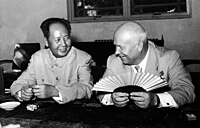
Photo from wikipedia
Sino-Russian security and economic cooperation has broadened and deepened in nonlinear but progressive fashion since the late 1990s. Contra realism, it is not simply American material power that drives this… Click to show full abstract
Sino-Russian security and economic cooperation has broadened and deepened in nonlinear but progressive fashion since the late 1990s. Contra realism, it is not simply American material power that drives this increasing cooperation; US power has at best remained constant. Instead, two conditions combine to deepen Sino-Russian cooperation. First, enduring liberal hegemony , or a combination of material power, prestige, and the ability to set and enforce rules, makes America threatening, under broad conditions, to any authoritarian regime’s domestic power and foreign influence. Hegemony is an interaction of material power and ideas; each augments the other. Second is the steady 20-year movement of Russia’s regime under Vladimir Putin away from liberal democracy. These two conditions make cooperation on either side of the liberal–nonliberal ideological divide increasingly easier than cooperation across it. Several types of qualitative evidence support these claims, including: (1) private and public statements from both Beijing and Moscow on the liberal-democratic threat; (2) specific deepening of bilateral cooperation after the Ukrainian revolution of 2014; (3) efforts by Moscow and Beijing to counter liberal hegemony’s spread in their regions; (4) the tendency for anti-liberal elites in neighboring states to cooperate more with China or Russia. I address realist counter-arguments skeptical of any systematic causal role for ideology. Insofar as America tires of its role as liberal hegemon, or the “China Model” becomes so prestigious as to threaten the Putin regime, the impetus to Sino-Russian cooperation identified here will fade.
Journal Title: International Politics
Year Published: 2020
Link to full text (if available)
Share on Social Media: Sign Up to like & get
recommendations!